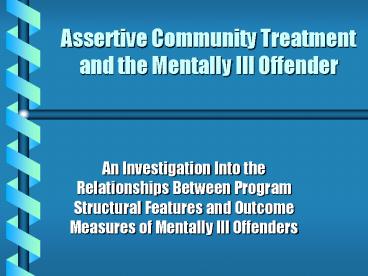Assertive Community Treatment and the Mentally Ill Offender - PowerPoint PPT Presentation
1 / 16
Title:
Assertive Community Treatment and the Mentally Ill Offender
Description:
Assertive Community Treatment and the Mentally Ill Offender An Investigation Into the Relationships Between Program Structural Features and Outcome Measures of ... – PowerPoint PPT presentation
Number of Views:125
Avg rating:3.0/5.0
Title: Assertive Community Treatment and the Mentally Ill Offender
1
Assertive Community Treatment and the Mentally
Ill Offender
- An Investigation Into the Relationships Between
Program Structural Features and Outcome Measures
of Mentally Ill Offenders
2
Structural Facets of Eight Factor Model
Team Intensity
- Contact Frequency
- Team Meeting
- Team Approach
- Service Intensity
- Small Caseload
3
Structural Facets of Eight Factor Model
Community Treatment
- In-Vivo Services
- Hospital Admissions Responsibility
- Treatment Responsibility
- Admissions Criteria
- Crisis Services
- Work With Supports
4
Structural Facets of Eight Factor Model
Engagement/Retention
- No-Drop Policy
- Assertive Engagement
- Hospital Discharge Planning
- Time-Unlimited Service
5
Structural Facets of Eight Factor Model
Substance Abuse Treatment
- Substance Abuse Groups
- Substance Abuse Treatment
- Dual-Disorder Model
6
Structural Facets of Eight Factor Model
Specialist Staffing
- Substance Abuse Specialist
- Nurse on Staff
- Psychiatrist on Staff
- Vocational Specialist
7
Structural Facets of Eight Factor Model
Caseload Distribution
- Team Leader Role
- Intake Rate
Staff Capacity and Continuity
- Staff Capacity
- Continuity of Staffing
8
Methods of Analysis
Logistic Regression
- Establish a relationship between an outcome and a
set of predictors - If one is found, simplify the model by
eliminating some of the predictors while still
maintaining strong prediction or explanatory
power - Dichotomize dependent variable into two groups
coded 0 1 - Examine strength of association
- Examine the effect of the change of each
predictor on the odds of being in one group or
the other
9
Outcome Measures
Dichotomized Criminal Engagement Index
- Number of bookings
- Number of convictions
- Number of days in jail
- Group 0 no criminal involvement
- Group 1 any degree of criminal involvement
10
Outcome Measures
Dichotomized Quality of Life Index
- First Eschelon of Quality of Life
- Type of Employment
- Living Arrangements
- Group 0 Unfavorable Life Situation
- Not in the paid work force
- Homeless or in intensive care
- Group 1 Favorable Life Situation
- Paid work force
- Group or independent living
- Second Eschelon of Quality of Life
- Non-Employment Sources of Income
11
ACTness and Criminal Engagement
Model 1
12
ACTness and Criminal Engagement
Model 2
13
ACTness and Criminal Engagement
Relative Importance of ACT Facets
- Substance Abuse Treatment (.255)
- Specialized Staffing (.250)
- Caseload Distribution (.204)
- Team Intensity (.176)
- Community Treatment (.097)
- Staff Capacity Continuity (-.100)
- Engagement Retention (n.s)
14
ACTness and Quality of Life Index
15
ACTness and Quality of Life Index
Relative Importance of ACT Facets
- Caseload Distribution (.334)
- Team Intensity (.324)
- Engagement Retention (.308)
- Community Treatment (.246)
- Specialist Staffing (.216)
- Staff Capacity Continuity (.000)
16
QUESTIONS?































